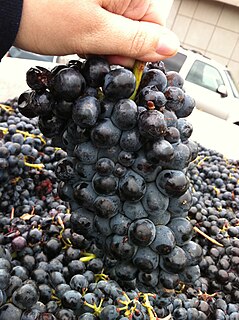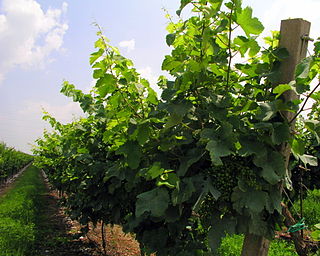
Barolo is a red Denominazione di Origine Controllata e Garantita (DOCG) wine produced in the northern Italian region of Piedmont. It is made from the nebbiolo grape and is often described as one of Italy's greatest wines.

Nebbiolo is an Italian red wine grape variety predominantly associated with its native Piedmont region, where it makes the Denominazione di Origine Controllata e Garantita (DOCG) wines of Barolo, Barbaresco, Roero, Gattinara, Carema and Ghemme. Nebbiolo is thought to derive its name from the Italian nebbia or Piedmontese nebia, meaning "fog". During harvest, which generally takes place late in October, a deep, intense fog sets into the Langhe region where many Nebbiolo vineyards are located. Alternative explanations refers to the fog-like glaucous veil that forms over the berries as they reach maturity, or that perhaps the name is derived instead from the Italian word nobile, meaning noble. Nebbiolo produces lightly-colored red wines which can be highly tannic in youth with scents of tar and roses. As they age, the wines take on a characteristic brick-orange hue at the rim of the glass and mature to reveal other aromas and flavors such as violets, tar, wild herbs, cherries, raspberries, truffles, tobacco, and prunes. Nebbiolo wines can require years of aging to balance the tannins with other characteristics.

Barbera is a red Italian wine grape variety that, as of 2000, was the third most-planted red grape variety in Italy. It produces good yields and is known for deep color, full body, low tannins and high levels of acidity.

Dolcetto is a black Italian wine grape variety widely grown in the Piedmont region of northwest Italy. The Italian word dolcetto means "little sweet one", but it is not certain that the name originally carried any reference to the grape’s sugar levels: it is possible that it derives from the name of the hills where the vine is cultivated. In any case the wines produced are nearly always dry. They can be tannic and fruity with moderate, or decidedly low, levels of acidity and are typically meant to be consumed within a few years after release.
Grignolino is a red Italian wine grape variety commonly grown in the Piedmont region. It makes light colored wines and rosés with very fruity aromas, strong acidity and tannins. The name Grignolino derives from the word grignole which means "many pips" in the local Piedmontese dialect of the Asti region. The abundance of pips, or seeds, contributes to the strong, bitter tannins associated with the wine. Modern winemakers try to avoid the excess tannins with gentle and slow pressings. Grignolino has three Denominazione di origine controllata (DOCs) that produce wine from it - Asti, Monferrato Casale, and Piemonte Grignolino.

Italian wine is produced in every region of Italy, home to some of the oldest wine-producing regions in the world. Italy is the world's largest producer of wine, with an area of 702,000 hectares under vineyard cultivation, and contributing a 2013–2017 annual average of 48.3 million hl of wine. In 2018 Italy accounted for 19 percent of global production, ahead of France and Spain. Italian wine is both exported around the world and popular domestically among Italians, who consume an average of 42 litres per capita, ranking fifth in world wine consumption.
Freisa is a red Italian wine grape variety grown in the Piedmont region of north-west Italy, primarily in Monferrato and in the Langhe, but also further north in the provinces of Turin and Biella. Freisa is a vigorous and productive vine whose round, blue-black grapes are harvested in early October. The three-lobed leaves are relatively small and the bunches are elongated in form. By the 1880s it had become one of the major Piedmontese grapes, and in that period its cultivation was stimulated by the vine’s resistance to the downy mildew caused by the Plasmopara viticola fungus. Wines made from the Freisa grape are red and usually somewhat sweet and lightly sparkling, or foaming. Still and fully sparkling versions are also produced, however, as are dry and more decidedly sweet styles. In the Canavese there is also a rosé which can be made primarily from Freisa according to Denominazione di origine controllata (DOC) regulations.

Piemonte wine is the range of Italian wines made in the region of Piedmont in the northwestern corner of Italy. The best-known wines from the region include Barolo and Barbaresco. They are made from the Nebbiolo grape. These wines are ideal for storage and a well-aged Barolo for instance may leave a feeling of drinking velvet because the tannins are polished and integrated more and more into the wine. As the wine matures the colour becomes more brownish and rust-red.

Arneis is a white Italian wine grape variety originating from Piedmont, Italy. It is most commonly found in the hills of the Roero, northwest of Alba, where it is part of the white Denominazione di Origine Controllata e Garantita (DOCG) wines of Roero. It can also be used to produce DOC wines in Langhe. Arneis is so called because it is regarded as a somewhat difficult variety to grow. It is a crisp and floral varietal, and has been grown for centuries in the region. The white wines made from the Arneis grape tend to be dry and full bodied with notes of pears and apricots.

Glera, also known as Prosecco, is a white variety of grape of Slovenian origin, which was brought to the village of Prosecco from the Karst region. The variety was formerly mostly referred to as Prosecco, but in the EU was renamed "Glera" in 2009 to make room for the protection of "Prosecco" as the name of a geographically-protected wine.

Incrocio Manzoni or Manzoni grapes is a family of grape varieties named after Professor Luigi Manzoni (1888-1968) of Italy's oldest school of oenology located in Conegliano, in the Veneto region. Manzoni created the new grape varieties by selecting, crossing and grafting vines from various vineyards during the 1920s and 1930s. The family includes both white and red grape varieties. Although most Manzonis are grown in northeastern Italy, they are mainly grown in the Piave area of Province of Treviso and are only now starting to be sold commercially in Europe and the United States.
Neyret is a red Italian wine grape variety that is grown in the mountainous Valle d'Aosta wine region of northwest Italy though most plantings are in the slightly less mountainous terrain of southeast Aosta Valley bordering the Piedmont wine region. DNA profiling has confirmed that the variety is a Vitis vinifera crossing of Mayolet and Roussin.
Albarossa is a red Italian wine grape variety that was created in the Veneto wine region in 1938 by grape breeder Giovanni Dalmasso at the Istituto Sperimentale per la Viticoltura in Conegliano. Dalmasso originally thought he created the grape from a crossing of Nebbiolo and Barbera but DNA profiling in 2009 confirmed that the "Nebbiolo" vine used wasn't Nebbiolo at all but rather a very old French wine grape variety from the Ardèche, Chatus. The confusion stemmed from a synonym of Chatus, Nebbiolo di Dronero.
Rossola nera is a red Italian wine grape variety that has been growing in the Valtellina region of Lombardy since at least the 17th century. In 2004 DNA profiling determined that the grape has a parent-offspring relationship with the Piedmont wine grape Nebbiolo though which variety is the parent and which is the offspring is not yet clear. However, most ampelographers believe that Nebbiolo is likely the parent variety since written records in Piedmont have noted Nebbiolo being grown since at least the 13th century.
Cascarolo bianco is a white Italian wine grape variety that is grown primarily in the Piedmont wine region of northwest Italy. The grape has a long history in the region and was noted in 1606 by Giovanni Battista Croce, vineyard owner and official jeweler to Charles Emmanuel I, Duke of Savoy, as growing in the hills around Torino and producing wine of high esteem. It was once thought that Cascarolo bianco was the same variety as the Hungarian wine grape Fehér Gohér but DNA profiling in the early 21st century determined that the two grapes are unrelated. Today ampelographers believe that the grape is an offspring of the Swiss wine grape Rèze with DNA evidence suggesting some relationship with another white Piedmontese grape, Erbaluce.
Vega is a white Italian wine grape variety that was created in 1937 by grape breeder Giovanni Dalmasso by crossing the Hungarian wine grape Furmint with the Croatian wine grape Malvazija Istarska. Developed at the Istituto Sperimentale per la Viticoltura of Conegliano in the Veneto wine region of northeast Italy, the grape has slowly spread since its release. As of 2000, there were 28 hectares of Vega planted throughout Italy.
Avanà is a red Italian wine grape variety that is grown in the Piedmont wine region of northwest Italy. Historically, the grape has also been grown in the Dauphiné and Savoie wine region of eastern France where it was known as Hibou noir and in the Valais region of Switzerland. The grape is most often used as a blending variety in the Denominazione di origine controllata (DOC) zones of Pinerolese, with Barbera, Persan, Freisa and Neretta Cuneese, and Valsusa, with Barbera, Dolcetto, Neretta Cuneese and other local red Piemontese varieties.
Uvalino is a red Italian wine grape variety that is grown in the Piedmont wine region of northwest Italy. While the name uvalino means "small berries", ampelographers believe that the name may be derived from uvario which in the local Piedmontese dialect was used to denote wine grapes that were primarily minor blending varieties.
Bianchetta Trevigiana is a white Italian wine grape variety that is grown in the Trentino-Alto Adige/Südtirol and Veneto wine regions of northeast Italy. Here the grape is rarely used a varietal but, instead, is a permitted blending grape adding acidity to the wines of several Denominazione di Origine Controllata (DOC) zones including the sparkling wine Prosecco and has also been used for vermouth production. The name Trevigiana is derived from the province of Treviso where the grape is believed to have originated from.
Bubbierasco is a red Italian wine grape variety that is grown in the province of Cuneo in the Piedmont wine region of northwest Italy. The grape is a natural crossing of the Nebbiolo grape, famous for the red wines of Barolo and Barbaresco, and Bianchetta di Saluzzo, a white grape variety that has been historically grown around the town of Saluzzo.










